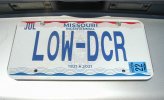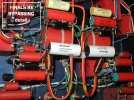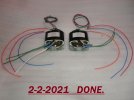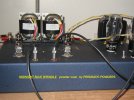2-13-2021 REPORT
The last week has been very focused on the development of the 6005 SE amplifier.
The ultra-large power transformer, shown in my last post, only lasted a few days on the new chassis, before I decided to remove it.
It was lovely to hear, because of it's 18 Ohms high voltage secondary D.C. Resistance, but the voltage it put out was a shade too high to optimize both tubes' operating points, on the Direct Coupled circuit.
I tried, and it was impossible !!
I went back to a Hammond 274BX power transformer, feeding it on it's 115 VAC primary tap. It allowed for a Direct Couple with
ideal operating points, for both tubes, my design goal.
What is an tube's ideal operating point, and how does one find it?
The answer is, after you look at graphs and data on a tube, you must then
listen to the tube at various plate voltages, and current draws, to
really find out what sounds best, on music playback. You won't see this on a o'scope.
As a general guide, one should use higher plate voltages than what is found in 99% of the commercial audio gear,
but the plate's currents must be correspondingly reduced, so as to operate the tube's
total overall dissipation, in a conservative, and long-tube-life manner. Higher plate voltage operating points allows the tube to swing more volts, resulting in more dynamics and an audible increase in apparent high frequency playback bandwidth. The speaker's playback into your room " opens up ", top to bottom, when so fed.
Allow me to use an example, a popular high gain audio tube, the 12AX7. Most designs will operate it at 150 volts on the plate ( Ea= 150 VDC. ) A few more designs will operate it Ea= 165 VDC.
Historically, 85-90% of all existing audio gear will operate the 12AX7 tube at 150 VDC to 165 VDC on the plate,
or lower.
Maybe 5 to 10% of the tube audio circuits will offer it running at 185 VDC on the plate ( Ea=185 VDC . ) Note : this Ea 185 VDC equipment sounds
vastly superior to 150-165 VDC. The tube is starting to swing and DO something !!!
The best example of this can be traced to a gentleman I personally knew, who started a company called Audio Research, William Zane Johnson. He knew enough to operate the 12AX7 at
high voltages with reduced currents. That is precisely why people were " floored " in the 1970s, when he introduced his famous SP3-A1 tube preamp, to rave reviews and consumer demand. Look at the schematic. He starts the preamp with a 500 VDC B+ supply, which he actively regulates down to 440 VDC, and feeds the 12AX7s with 440 VDC of B+ ( not on the plate ! ) . This allows the use of
high value plate resistors, and cathode resistors, and the tube SWINGS VOLTAGEs, and actually does something, musically, VS all the preceding preamplifiers known to the public !! Yes, Bill
was smart - knew how to operate the tube, no one before him did so to my knowledge.
A superb operating point for the 12AX7, where it sounds the best, is Ea= 195 VDC, with only 3/4s of a milliampere of current. Listen to that, you will like it musically !!
Back to my 6005 amp. I had never used a 6DJ8 before, and
I had to find it's best Operating Point, VDC-wise. Well, I started at about 165 VDC, and recorded all the key voltages, after listening to reference music selections. In the last week, I must have made
15 changes ( higher in plate voltage), listening intently to the same music selections, and documenting each change with full amplifier voltage and current measurements.
At last , yesterday, on 2-12-2021, I arrived where I wanted to be, VDC wise and total tube dissipation wise ( low and conservative and long lasting ). Depending upon one's line voltage in the USA where I reside, I ended up selecting by ear 204 VDC ( 120 VAC line ) and 210.8 VDC ( 125 VAC line ), as the best performing VDC plate voltages for a 6DJ8.
The differences are so easy to hear, and vast, on my ALTEC A7-8 Voice of the Theatre speakers. I am very pleased, to have now done this listening work, as it will apply to any 6DJ8, or its variants ( 6922, or what I really expect to use, a Russian 6N23P-EV triode. )
Additionally, with these 15 circuit changes, I was also able to optimize the operation of the 6005 FINALS tubes. I operate output tubes conservatively, usually at
62% of the tube's maximum rated dissipation. 62% is the Golden Ratio percentage, and
one of my goals, for best long-term tube sound and long life.
I ended up with my 6005s measured operating at 61.11% ( of maximum rated dissipation ) at 120 VAC and 66.84% at 125 VAC, which is a reasonable compromise on total tube dissipation, and close to the Golden Ratio.
So I have no sexy pictures to show you of the last week's work. But as of today, I am very satisfied with the week's listening and measuring results. My gut feeling right now is, this will become the best sounding amp I have ever built, given some normal development time. No one in audio has ever executed a 6005 amp as this is being done, that is for sure.
Still haven't mounted the Softone output transformers, nor installed 6N23P-EVs. This past week's work took priority.
Here is some
compelling information on R-Core transformers, which relates
directly to the unique Softone RW-20.
https://www.custommag.com/r-core-transformers.
Also, correction, in my first post, an error. The plate dissipation of a 6005 is 12 Watts, not 10 Watts.
































